Long-Term Variability of Surface Ozone and Its Associations with NOx and Air Temperature Changes from Air Quality Monitoring at Belsk, Poland, 1995–2023
Abstract
:1. Introduction
2. Materials and Methods
2.1. Site Description
2.2. Data Used
3. Results
3.1. Trends in Annual and Seasonal Data
3.1.1. O3 Time Series
3.1.2. NOx Time Series
3.1.3. Air Temperature Time Series
3.1.4. Trends in Monthly and Hourly Extremes
3.2. Relationship between Surface O3 and Air Temperature
3.3. Ozone–Climate Penalty
3.4. Photochemical Ox Production Regime
4. Discussion
5. Conclusions
- O3 trends depend on the period studied, as well as the season and the selected statistical characteristics (95th and 5th percentile, median, 1 h and monthly extremes). Trends may even be opposite in two consecutive sub-periods (e.g., 95th percentile for summer in 1995–2004 and 2005–2014). Therefore, when comparing trends between stations, always consider the same period, season and statistical characteristics.
- The lack of seasonal trends in local and regional contributions to O3 variability has stabilized the average O3 level in Belsk since 1995.
- Currently, the appearance of photochemical smog in Belsk is very unlikely.
- Average O3 levels will increase with global warming, but the reduction in the ozone–climate penalty factor observed at many sites, including Belsk, suggests that any estimate of future average O3 levels should be treated with caution.
Author Contributions
Funding
Institutional Review Board Statement
Informed Consent Statement
Data Availability Statement
Conflicts of Interest
Appendix A
| O3 [µg/m3] | NOx [µg/m3] | Temperature [°C] | ||||||||||
|---|---|---|---|---|---|---|---|---|---|---|---|---|
| 1995– 2004 | 2005– 2014 | 2015– 2023 | 1995– 2023 | 1995– 2004 | 2005– 2014 | 2015– 2023 | 1995– 2023 | 1995– 2004 | 2005– 2014 | 2015– 2023 | 1995– 2023 | |
| Year | Year | Year | ||||||||||
| 1st Qu | 34.0 | 32.8 | 35.9 | 34.0 | 6.0 | 5.9 | 5.2 | 5.6 | 0.6 | 2.1 | 3.2 | 1.9 |
| Median | 52.0 | 51.0 | 52.6 | 52.0 | 8.7 | 9.4 | 8.3 | 8.8 | 8.6 | 9.1 | 9.5 | 9.1 |
| Mean | 55.2 | 53.5 | 54.6 | 54.4 | 10.3 | 12.0 | 10.4 | 11.0 | 8.3 | 9.0 | 10.0 | 9.0 |
| 3rd Qu | 73.5 | 71.3 | 70.7 | 71.9 | 13.0 | 15.2 | 13.1 | 13.8 | 15.8 | 15.9 | 16.6 | 16.1 |
| Max | 208.0 | 188.9 | 187.5 | 208.0 | 77.6 | 155.6 | 165.9 | 165.9 | 33.6 | 36.7 | 36.4 | 36.7 |
| Spring | Spring | Spring | ||||||||||
| 1st Qu | 56.0 | 55.2 | 54.5 | 55.2 | 6.0 | 5.2 | 5.1 | 5.4 | 2.7 | 4.1 | 4.5 | 3.7 |
| Median | 71.5 | 70.8 | 68.2 | 70.0 | 9.0 | 8.2 | 7.7 | 8.2 | 8.3 | 9.0 | 8.9 | 8.7 |
| Mean | 73.2 | 72.0 | 69.1 | 71.5 | 10.0 | 10.1 | 9.4 | 9.8 | 8.3 | 9.0 | 9.2 | 8.8 |
| 3rd Qu | 89.0 | 87.4 | 83.0 | 86.4 | 12.6 | 12.9 | 11.8 | 12.4 | 13.5 | 13.7 | 13.7 | 13.6 |
| Max | 182.0 | 188.9 | 147.8 | 188.9 | 61.4 | 98.4 | 101.9 | 101.9 | 13.5 | 32.0 | 30.2 | 32.0 |
| Summer | Summer | Summer | ||||||||||
| 1st Qu | 48.3 | 45.4 | 46.7 | 46.9 | 4.1 | 4.5 | 4.0 | 4.2 | 15.3 | 15.3 | 16.2 | 15.5 |
| Median | 66.6 | 62.9 | 63.7 | 64.4 | 6.0 | 6.8 | 6.4 | 6.4 | 18.2 | 18.4 | 19.1 | 18.6 |
| Mean | 69.9 | 65.8 | 66.7 | 67.5 | 7.1 | 8.2 | 7.7 | 7.7 | 18.6 | 18.8 | 19.6 | 19.0 |
| 3rd Qu | 89.0 | 84.0 | 84.9 | 86.0 | 9.0 | 10.3 | 9.9 | 9.8 | 21.6 | 22.0 | 22.7 | 22.1 |
| Max | 208.0 | 180.6 | 187.5 | 208.0 | 42.0 | 128.6 | 76.0 | 128.6 | 33.6 | 36.7 | 36.4 | 36.7 |
| St. Dev. | 29.0 | 27.3 | 26.7 | 27.7 | 4.1 | 5.6 | 5.3 | 5.1 | 4.5 | 4.9 | 4.8 | 4.8 |
| Autumn | Autumn | Autumn | ||||||||||
| 1st Qu | 23.0 | 20.5 | 24.7 | 22.8 | 6.0 | 7.2 | 5.9 | 6.4 | 3.7 | 5.1 | 6.1 | 4.9 |
| Median | 37.0 | 34.2 | 38.0 | 36.3 | 9.0 | 11.3 | 9.1 | 9.8 | 8.5 | 9.0 | 9.8 | 9.1 |
| Mean | 39.0 | 36.5 | 40.5 | 38.6 | 10.5 | 13.8 | 11.2 | 11.9 | 8.3 | 9.2 | 10.1 | 9.1 |
| 3rd Qu | 51.1 | 49.9 | 52.7 | 51.3 | 13.0 | 17.3 | 14.0 | 14.8 | 12.8 | 13.1 | 14.0 | 13.2 |
| Max | 171.0 | 140.6 | 173.6 | 173.6 | 77.6 | 130.1 | 108.2 | 130.1 | 29.2 | 30.4 | 30.3 | 30.4 |
| Winter | Winter | Winter | ||||||||||
| 1st Qu | 23.0 | 25.1 | 28.5 | 25.4 | 7.5 | 7.8 | 6.6 | 7.2 | −5.7 | −4.2 | −1.4 | −4.0 |
| Median | 38.0 | 39.3 | 42.6 | 40.0 | 11.0 | 12.8 | 10.7 | 11.5 | −1.7 | −0.2 | 1.0 | −0.2 |
| Mean | 38.6 | 39.4 | 41.9 | 39.9 | 13.3 | 16.1 | 13.3 | 14.3 | −2.5 | −1.1 | 0.9 | −1.0 |
| 3rd Qu | 52.3 | 53.0 | 55.6 | 53.8 | 16.5 | 20.8 | 17.0 | 18.0 | 1.1 | 2.8 | 3.9 | 2.6 |
| Max | 134.3 | 120.9 | 101.6 | 134.3 | 75.2 | 155.6 | 165.9 | 165.9 | 14.0 | 14.1 | 16.8 | 16.8 |
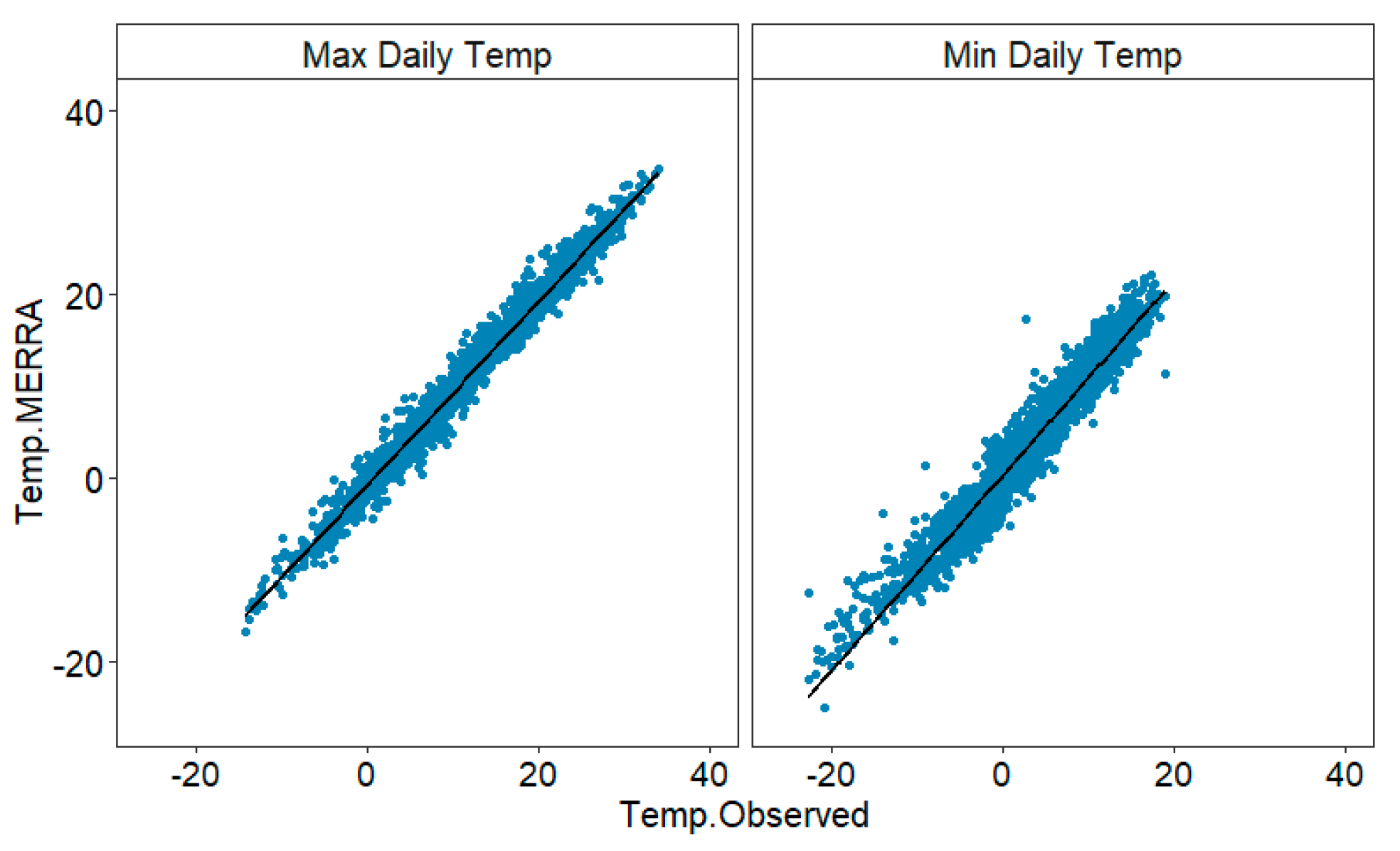

References
- Intergovernmental Panel on Climate Change (IPCC). Climate Change 2022—Impacts, Adaptation and Vulnerability; Cambridge University Press: Cambridge, UK, 2023. [Google Scholar]
- Lelieveld, J.; Evans, J.S.; Fnais, M.; Giannadaki, D.; Pozzer, A. The Contribution of Outdoor Air Pollution Sources to Premature Mortality on a Global Scale. Nature 2015, 525, 367–371. [Google Scholar] [CrossRef] [PubMed]
- Lelieveld, J.; Dentener, F.J. What Controls Tropospheric Ozone? J. Geophys. Res. Atmos. 2000, 105, 3531–3551. [Google Scholar] [CrossRef]
- Jiang, W.; Singleton, D.L.; Hedley, M.; Mclaren, R. Sensitivity of Ozone concentrations to VOC and NOx Emissions in the Canadian Lower Fraser Valley. Atmos. Environ. 1997, 31, 627–638. [Google Scholar] [CrossRef]
- Sillman, S. Chapter 12 The Relation between Ozone, NOx and Hydrocarbons in Urban and Polluted Rural Environments. In Developments in Environmental Science; Elsevier: Amsterdam, The Netherlands, 2002; Volume 1. [Google Scholar] [CrossRef]
- Li, M.; Karu, E.; Brenninkmeijer, C.; Fischer, H.; Lelieveld, J.; Williams, J. Tropospheric OH and Stratospheric OH and Cl Concentrations Determined from CH4, CH3Cl, and SF6 Measurements. NPJ Clim. Atmos. Sci. 2018, 1, 29. [Google Scholar] [CrossRef]
- Flowerday, C.E.; Thalman, R.; Hansen, J.C. Local and Regional Contributions to Tropospheric Ozone Concentrations. Atmosphere 2023, 14, 1262. [Google Scholar] [CrossRef]
- Sillman, S.; He, D. Some Theoretical Results Concerning O3-NOx-VOC Chemistry and NOx-VOC Indicators. J. Geophys. Res. Atmos. 2002, 107, ACH 26-1–ACH 26-15. [Google Scholar] [CrossRef]
- Pusede, S.E.; Steiner, A.L.; Cohen, R.C. Temperature and Recent Trends in the Chemistry of Continental Surface Ozone. Chem. Rev. 2015, 115, 3898–3918. [Google Scholar] [CrossRef]
- Abeleira, A.J.; Farmer, D.K. Summer Ozone in the Northern Front Range Metropolitan Area: Weekend-Weekday Effects, Temperature Dependences, and the Impact of Drought. Atmos. Chem. Phys. 2017, 17, 6517–6529. [Google Scholar] [CrossRef]
- Leighton, P.A. Photochemistry of Air Pollution; Academic Press: New York, NY, USA, 1961. [Google Scholar]
- Clapp, L.J.; Jenkin, M.E. Analysis of the Relationship between Ambient Levels of O3, NO2 and NO as a Function of NOx in the UK. Atmos. Environ. 2001, 35, 6391–6405. [Google Scholar] [CrossRef]
- Derwent, R.G.; Hjellbrekke, A.-G. Air Pollution by Ozone Across Europe. In Urban Air Quality in Europe; Springer: Berlin/Heidelberg, Germany, 2012; pp. 55–73. [Google Scholar]
- Yan, Y.; Lin, J.; Pozzer, A.; Kong, S.; Lelieveld, J. Trend Reversal from High-to-Low and from Rural-to-Urban Ozone Concentrations over Europe. Atmos. Environ. 2019, 213, 25–36. [Google Scholar] [CrossRef]
- Guerreiro, C.B.B.; Foltescu, V.; de Leeuw, F. Air Quality Status and Trends in Europe. Atmos. Environ. 2014, 98, 376–384. [Google Scholar] [CrossRef]
- Querol, X.; Alastuey, A.; Reche, C.; Orio, A.; Pallares, M.; Reina, F.; Dieguez, J.J.; Mantilla, E.; Escudero, M.; Alonso, L.; et al. On the Origin of the Highest Ozone Episodes in Spain. Sci. Total Environ. 2016, 572, 379–389. [Google Scholar] [CrossRef] [PubMed]
- Colette, A.; Andersson, C.; Manders, A.; Mar, K.; Mircea, M.; Pay, M.T.; Raffort, V.; Tsyro, S.; Cuvelier, C.; Adani, M.; et al. EURODELTA-Trends, a Multi-Model Experiment of Air Quality Hindcast in Europe over 1990–2010. Geosci. Model Dev. 2017, 10, 3255–3276. [Google Scholar] [CrossRef]
- Atkinson, R. Gas-Phase Tropospheric Chemistry of Organic Compounds: A Review. Atmos. Environ. Part A Gen. Top. 1990, 24, 1–41. [Google Scholar] [CrossRef]
- Guenther, A.; Karl, T.; Harley, P.; Wiedinmyer, C.; Palmer, P.I.; Geron, C. Estimates of Global Terrestrial Isoprene Emissions Using MEGAN (Model of Emissions of Gases and Aerosols from Nature). Atmos. Chem. Phys. 2006, 6, 3181–3210. [Google Scholar] [CrossRef]
- Roberts, J.M.; Bertman, S.B. The Thermal Decomposition of Peroxyacetic Nitric Anhydride (PAN) and Peroxymethacrylic Nitric Anhydride (MPAN). Int. J. Chem. Kinet. 1992, 24, 297–307. [Google Scholar] [CrossRef]
- Weng, H.; Lin, J.; Martin, R.; Millet, D.B.; Jaeglé, L.; Ridley, D.; Keller, C.; Li, C.; Du, M.; Meng, J. Global High-Resolution Emissions of Soil NOx, Sea Salt Aerosols, and Biogenic Volatile Organic Compounds. Sci. Data 2020, 7, 148. [Google Scholar] [CrossRef] [PubMed]
- Bloomer, B.J.; Stehr, J.W.; Piety, C.A.; Salawitch, R.J.; Dickerson, R.R. Observed Relationships of Ozone Air Pollution with Temperature and Emissions. Geophys. Res. Lett. 2009, 36, L09803. [Google Scholar] [CrossRef]
- Brown, F.; Folberth, G.A.; Sitch, S.; Bauer, S.; Bauters, M.; Boeckx, P.; Cheesman, A.W.; Deushi, M.; Dos Santos Vieira, I.; Galy-Lacaux, C.; et al. The Ozone-Climate Penalty over South America and Africa by 2100. Atmos. Chem. Phys. 2022, 22, 12331–12352. [Google Scholar] [CrossRef]
- Zanis, P.; Akritidis, D.; Turnock, S.; Naik, V.; Szopa, S.; Georgoulias, A.K.; Bauer, S.E.; Deushi, M.; Horowitz, L.W.; Keeble, J.; et al. Climate Change Penalty and Benefit on Surface Ozone: A Global Perspective Based on CMIP6 Earth System Models. Environ. Res. Lett. 2022, 17, 024014. [Google Scholar] [CrossRef]
- Posyniak, M.; Szkop, A.; Pietruczuk, A.; Podgórski, J.; Krzyścin, J. The Long-Term (1964–2014) Variability of Aerosol Optical Thickness and Its Impact on Solar Irradiance Based on the Data Taken at Belsk, Poland. Acta Geophys. 2016, 64, 1858–1874. [Google Scholar] [CrossRef]
- De Brito, C.; Guerreiro, B.; Profile, S.; González Ortiz, A. Air Quality 2018—EEA Report 12 2018. Available online: https://op.europa.eu/en/publication-detail/-/publication/223e663b-1340-11e9-81b4-01aa75ed71a1/language-en (accessed on 1 August 2024). [CrossRef]
- Global Modeling and Assimilation Office (GMAO). MERRA-2 Inst1_2d_lfo_Nx: 2d,1-Hourly, Instantaneous, Single-Level, Assimilation, Land Surface Forcings V5.12.4, Greenbelt, MD, USA, Goddard Space Flight Center Distributed Active Archive Center (GSFC DAAC). 2015. Available online: https://disc.gsfc.nasa.gov/datasets/M2I1NXLFO_5.12.4/summary (accessed on 28 May 2024). [CrossRef]
- Cleveland, W.S. Robust Locally Weighted Regression and Smoothing Scatterplots. J. Am. Stat. Assoc. 1979, 74, 829–836. [Google Scholar] [CrossRef]
- Otero, N.; Rust, H.W.; Butler, T. Temperature Dependence of Tropospheric Ozone under NOx Reductions over Germany. Atmos. Environ. 2021, 253, 118334. [Google Scholar] [CrossRef]
- Monks, P.S. A Review of the Observations and Origins of the Spring Ozone Maximum. Atmos. Environ. 2000, 34, 3545–3561. [Google Scholar] [CrossRef]
- Wilson, R.C.; Fleming, Z.L.; Monks, P.S.; Clain, G.; Henne, S.; Konovalov, I.B.; Szopa, S.; Menut, L. Have Primary Emission Reduction Measures Reduced Ozone across Europe? An Analysis of European Rural Background Ozone Trends 1996–2005. Atmos. Chem. Phys. 2012, 12, 437–454. [Google Scholar] [CrossRef]
- Dentener, F.; Keating, T.; Akimoto, H. Convention on Long-range Transboundary Air Pollution. Task Force on Hemispheric Transport of Air Pollution. In Hemispheric Transport of Air Pollution 2010. Part A, Ozone and Particulate Matter; United Nations. Economic Commission for Europe: Geneva, The Netherlands, 2010. [Google Scholar]
- Ordóñez, C.; Brunner, D.; Staehelin, J.; Hadjinicolaou, P.; Pyle, J.A.; Jonas, M.; Wernli, H.; Prévot, A.S.H. Strong Influence of Lowermost Stratospheric Ozone on Lower Tropospheric Background Ozone Changes over Europe. Geophys. Res. Lett. 2007, 34, L07805. [Google Scholar] [CrossRef]
- Aas, W.; Fagerli, H.; Alastuey, A.; Cavalli, F.; Degorska, A.; Feigenspan, S.; Brenna, H.; Gliß, J.; Heinesen, D.; Hueglin, C.; et al. Trends in Air Pollution in Europe, 2000–2019. Aerosol Air Qual. Res. 2024, 24, 230237. [Google Scholar] [CrossRef]
- Directive 2008/50/EC of the European Parliament and of the Council of 21 May 2008 on Ambient Air Quality and Cleaner Air for Europe. Available online: https://www.eea.europa.eu/policy-documents/directive-2008-50-ec-of (accessed on 31 July 2024).
- Boleti, E.; Hueglin, C.K.; Grange, S.; Takahama, S. Temporal and Spatial Analysis of Ozone Concentrations in Europe Based on Timescale Decomposition and a Multi-Clustering Approach. Atmos. Chem. Phys. 2020, 20, 9051–9066. [Google Scholar] [CrossRef]
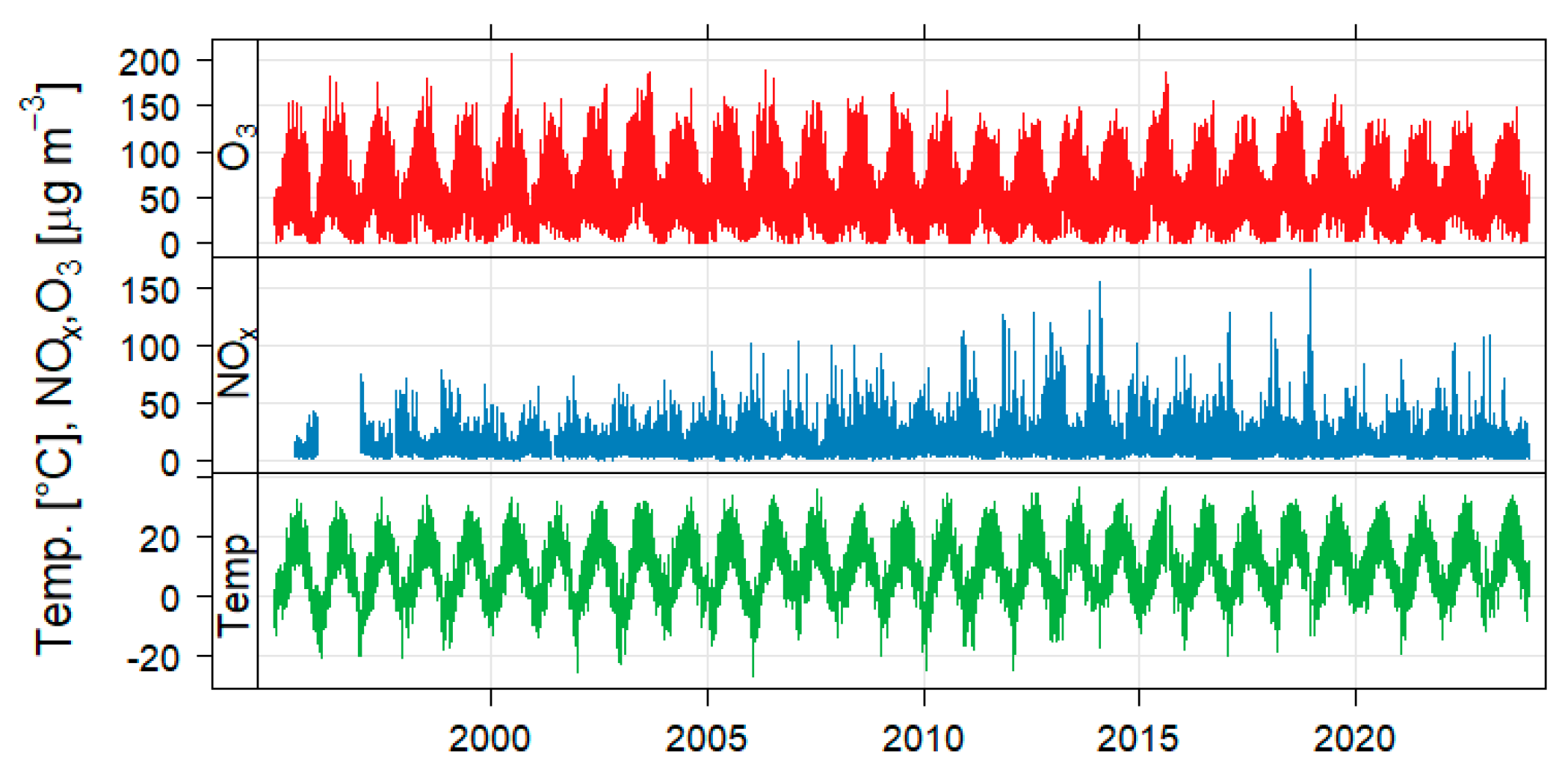
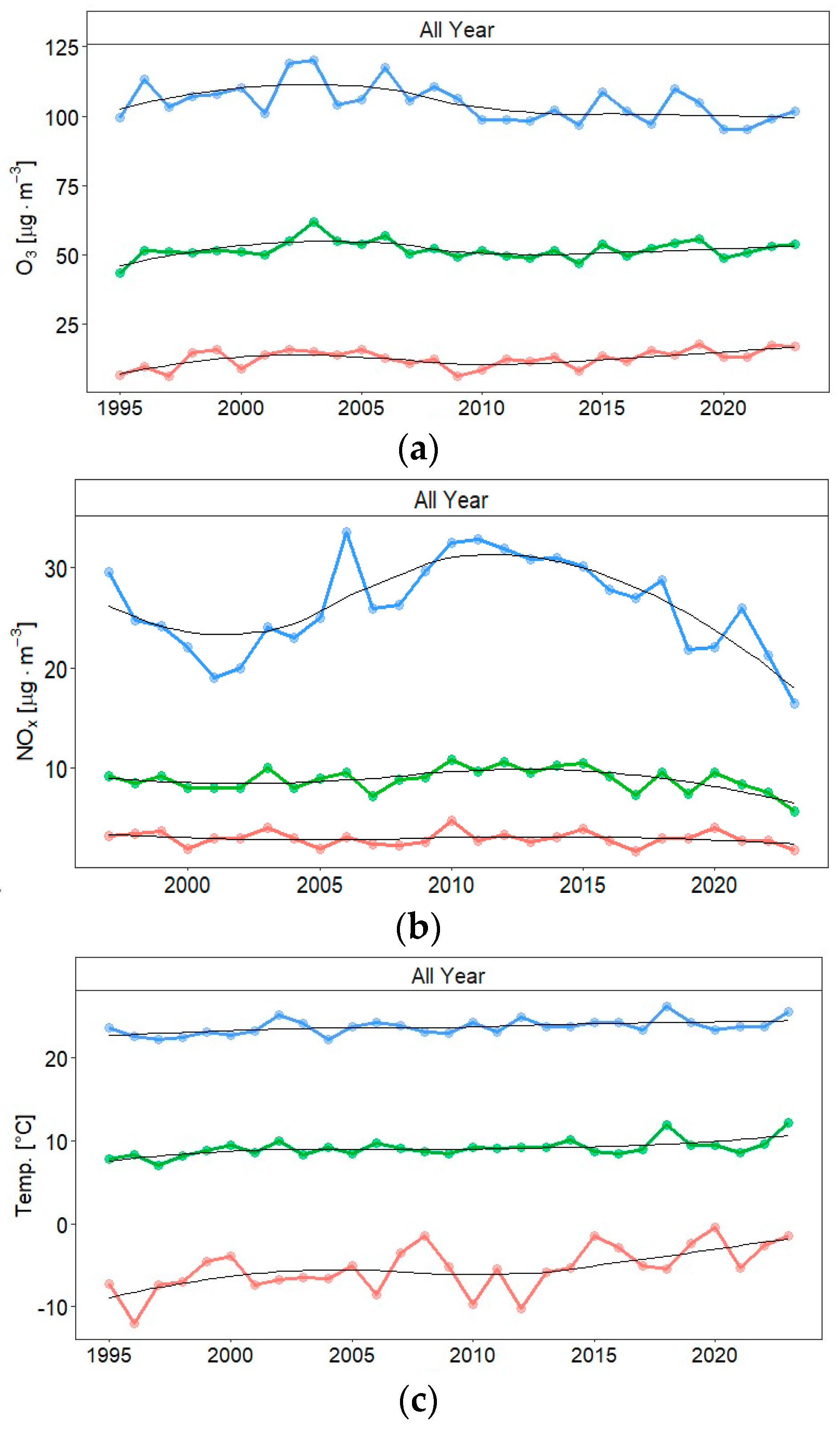

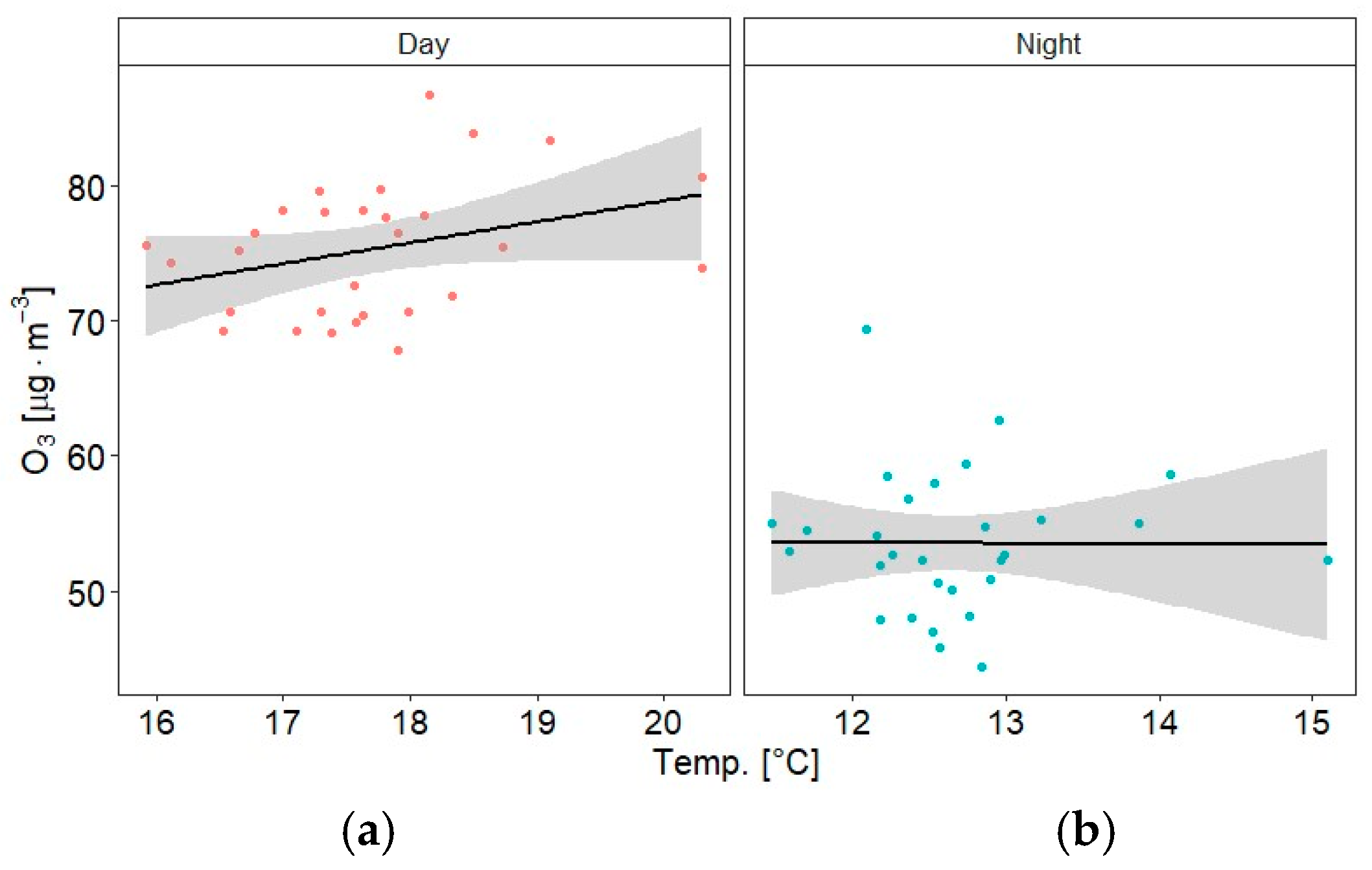

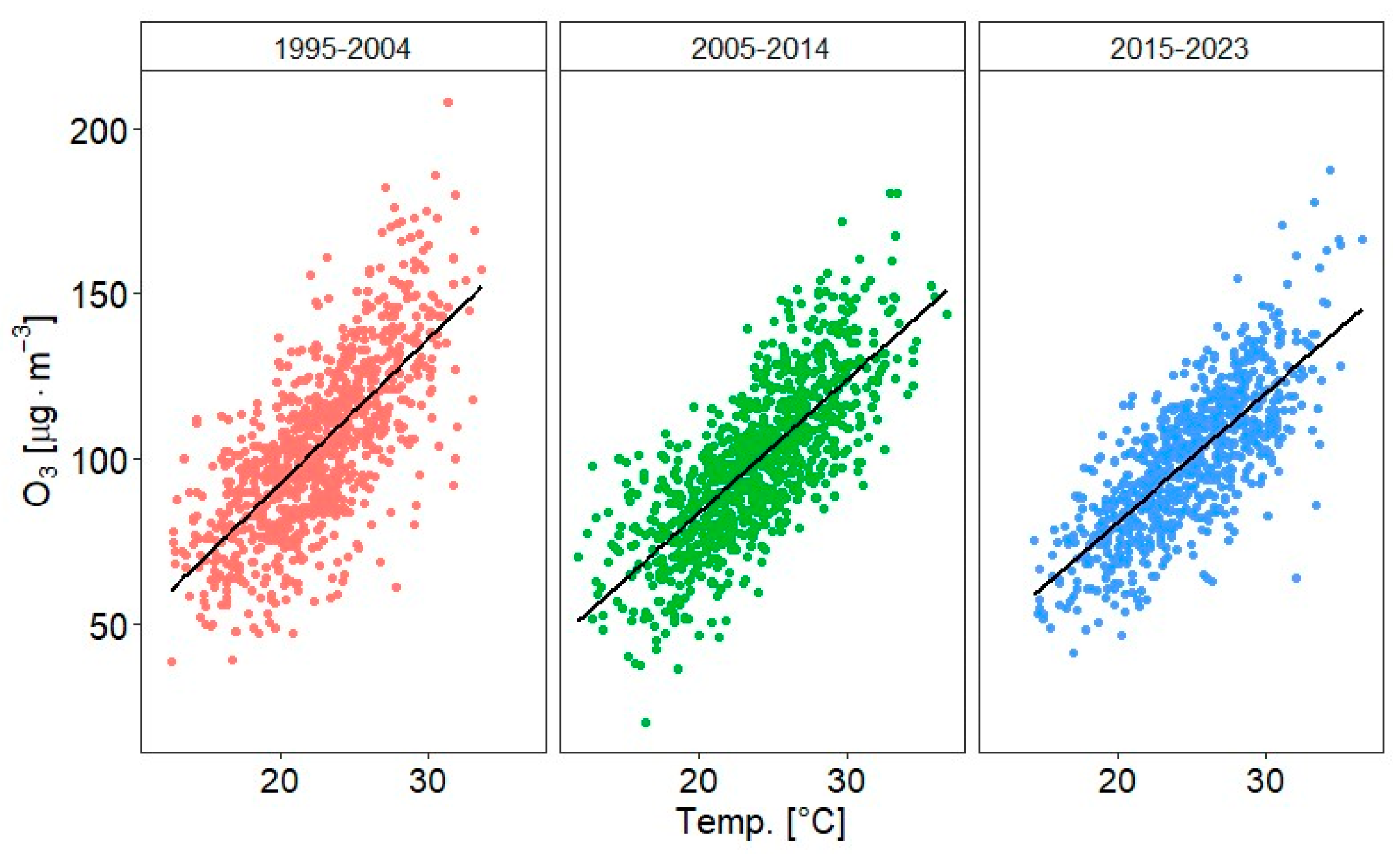
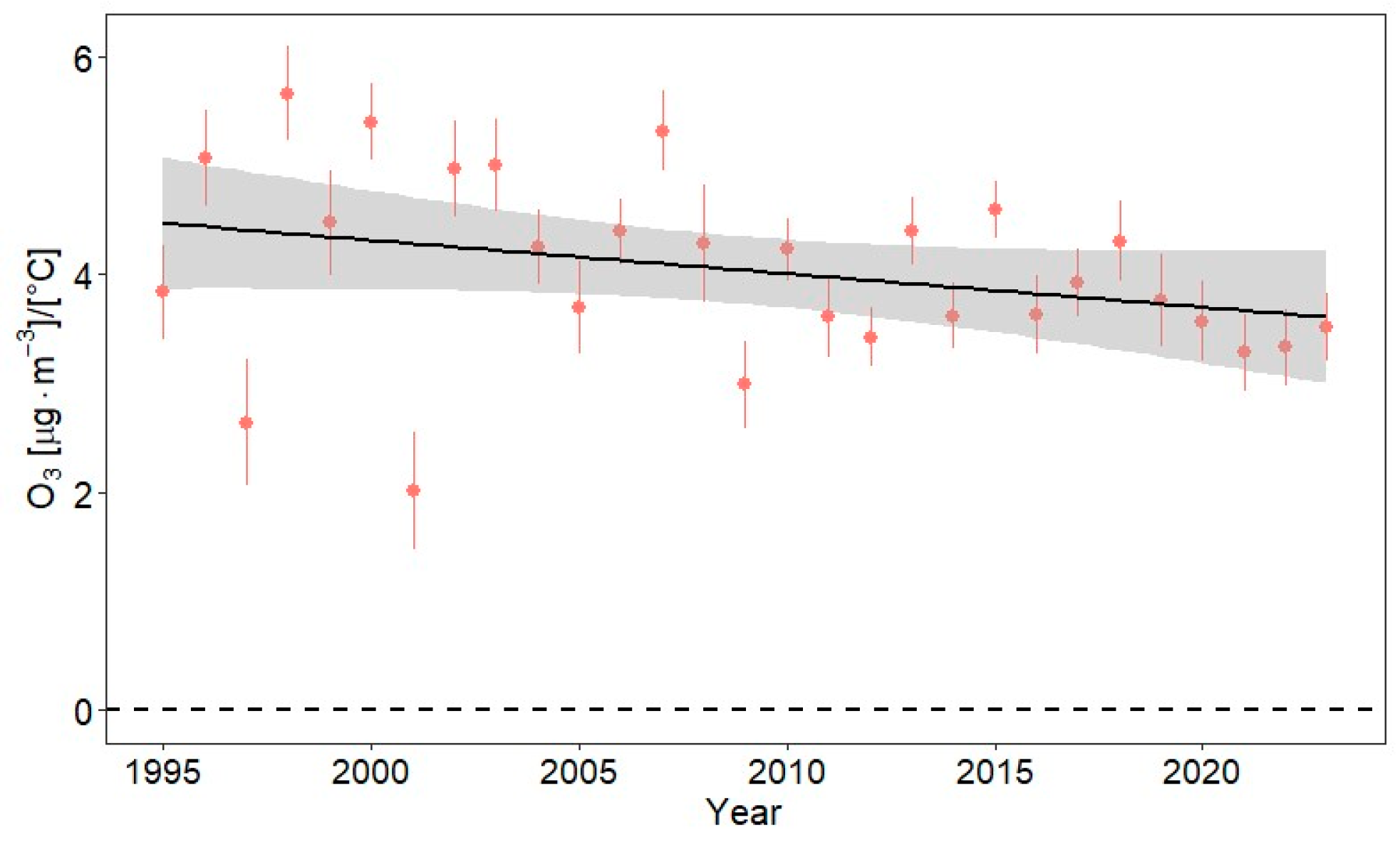

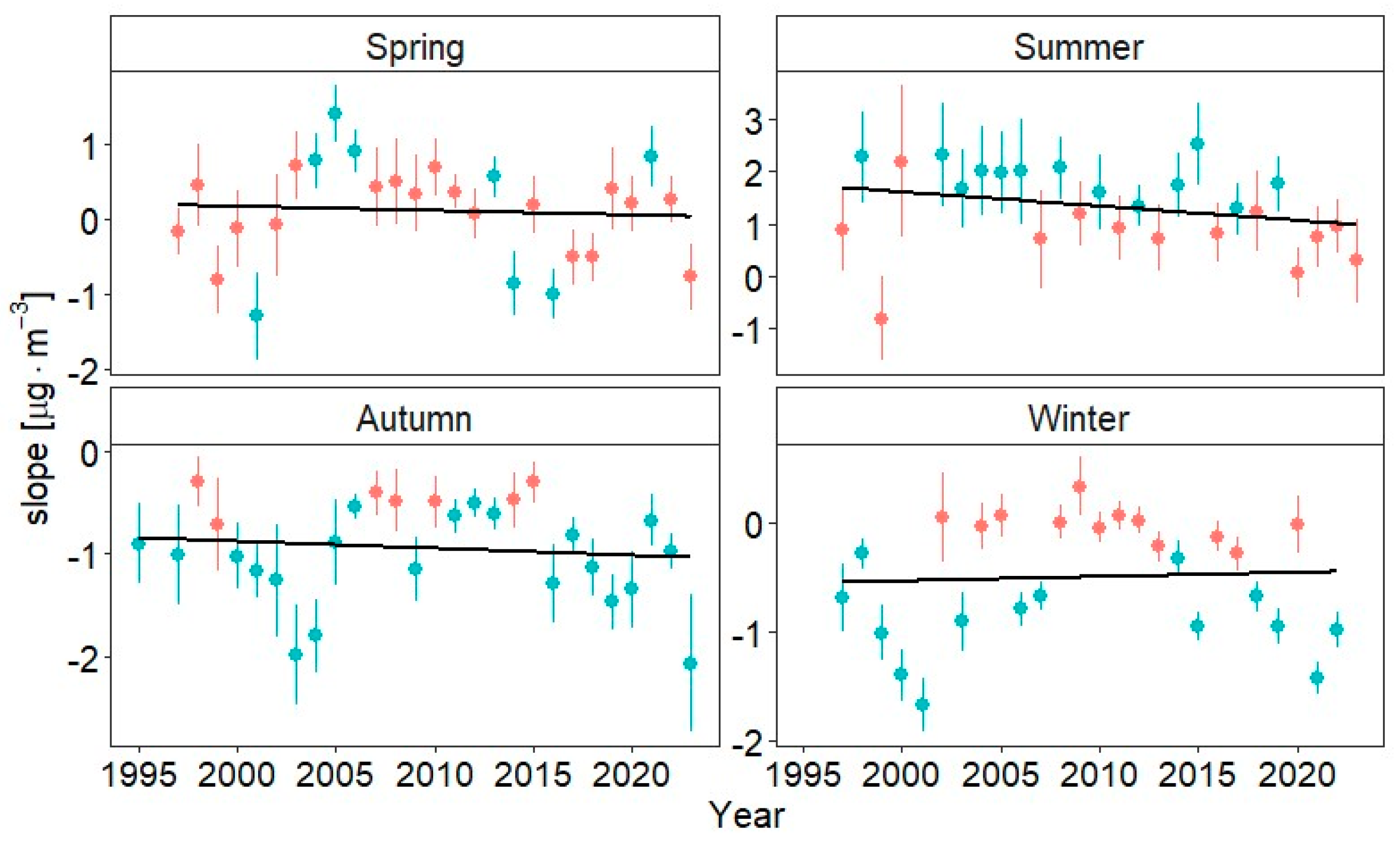

Disclaimer/Publisher’s Note: The statements, opinions and data contained in all publications are solely those of the individual author(s) and contributor(s) and not of MDPI and/or the editor(s). MDPI and/or the editor(s) disclaim responsibility for any injury to people or property resulting from any ideas, methods, instructions or products referred to in the content. |
© 2024 by the authors. Licensee MDPI, Basel, Switzerland. This article is an open access article distributed under the terms and conditions of the Creative Commons Attribution (CC BY) license (https://creativecommons.org/licenses/by/4.0/).
Share and Cite
Pawlak, I.; Krzyścin, J.; Jarosławski, J. Long-Term Variability of Surface Ozone and Its Associations with NOx and Air Temperature Changes from Air Quality Monitoring at Belsk, Poland, 1995–2023. Atmosphere 2024, 15, 960. https://doi.org/10.3390/atmos15080960
Pawlak I, Krzyścin J, Jarosławski J. Long-Term Variability of Surface Ozone and Its Associations with NOx and Air Temperature Changes from Air Quality Monitoring at Belsk, Poland, 1995–2023. Atmosphere. 2024; 15(8):960. https://doi.org/10.3390/atmos15080960
Chicago/Turabian StylePawlak, Izabela, Janusz Krzyścin, and Janusz Jarosławski. 2024. "Long-Term Variability of Surface Ozone and Its Associations with NOx and Air Temperature Changes from Air Quality Monitoring at Belsk, Poland, 1995–2023" Atmosphere 15, no. 8: 960. https://doi.org/10.3390/atmos15080960






